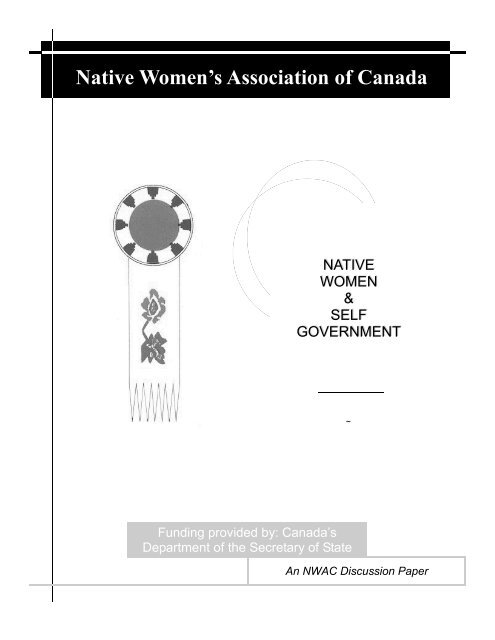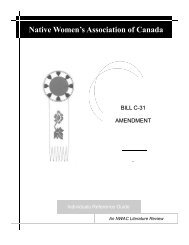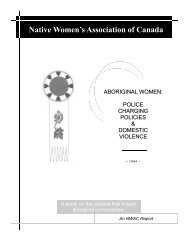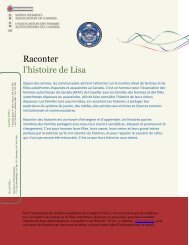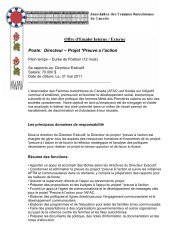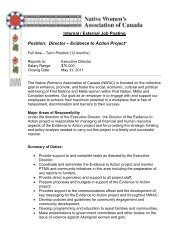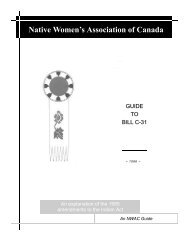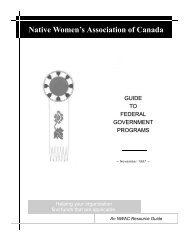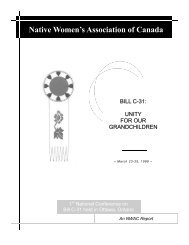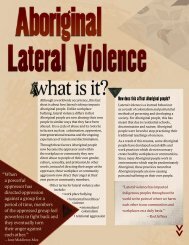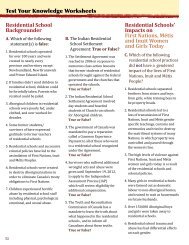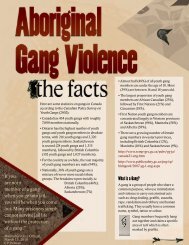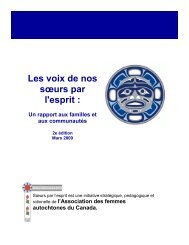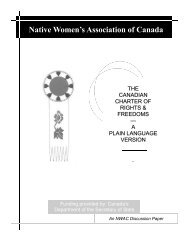Native Women & Self-Government - Native Women's Association of ...
Native Women & Self-Government - Native Women's Association of ...
Native Women & Self-Government - Native Women's Association of ...
Create successful ePaper yourself
Turn your PDF publications into a flip-book with our unique Google optimized e-Paper software.
<strong>Native</strong> <strong>Women</strong>’s <strong>Association</strong> <strong>of</strong> CanadaNATIVEWOMEN&SELFGOVERNMENT~Funding provided by: Canada’sDepartment <strong>of</strong> the Secretary <strong>of</strong> StateAn NWAC Discussion Paper
Table <strong>of</strong> Contents1. The Canadian Constitution....................................................... 32. Difference Between Delegated Powers & <strong>Self</strong>-<strong>Government</strong> ... 43. Federal <strong>Government</strong> Proposal for <strong>Self</strong>-<strong>Government</strong> ............... 54. The Process <strong>of</strong> Negotiation ...................................................... 65. Should Protection for Individual Rights be Built into <strong>Self</strong>-<strong>Government</strong>?............................................................................ 76. <strong>Self</strong>-<strong>Government</strong> and International Law................................... 87. What Choices Do We Have? ................................................... 9a) An "Aboriginal Charter" ................................................................9b) The Canadian Charter <strong>of</strong> Rights and Freedoms ........................108. Conclusion .............................................................................. 10Pg. 2
<strong>Native</strong> <strong>Women</strong> & <strong>Self</strong>-<strong>Government</strong>In this document we discuss some <strong>of</strong> the issues facing <strong>Native</strong> women in the discussionsabout self-government which are now taking place. These discussions are aboutchanging the Constitution <strong>of</strong> Canada so that an Aboriginal right to self-government willbe included specifically in it.1. The Canadian ConstitutionThe Constitution <strong>of</strong> a nation is the supreme law <strong>of</strong> that nation. It sets out the basic rulesand principles which everyone in the nation, including the government, must follow andrespect. The Canadian Constitution was originally created in 1867. It has been changedseveral times since then in order to take into account new and different ideas as theyoccur, or to deal with new problems that arise as Canadian society changes over time.The Canadian Constitution contains rules which the federal and provincial governmentsmust respect. It limits the powers <strong>of</strong> the governments in two ways. The first kinds <strong>of</strong>limits are called "jurisdictional" limits. That is, there are a number <strong>of</strong> subjects aboutwhich the federal government can make laws, and there are other subjects about whichthe provincial governments can make laws.The federal government cannot make laws about subjects which are under provincialjurisdiction and the provincial governments cannot make laws about subjects which areunder federal jurisdiction. Therefore, each government is limited in the kinds <strong>of</strong> lawswhich it can pass. For example, a provincial government does not have the power tomake laws about "Indians and lands reserved for the Indians" because only the federalgovernment has the "jurisdiction" to do this.The second kind <strong>of</strong> limit is contained in the Canadian Charter <strong>of</strong> Rights and Freedoms.The Charter is part <strong>of</strong> the Constitution and it provides certain rules which the federal andprovincial governments must respect. For more information on the Charter, please readthe two discussion papers called "The Canadian Charter <strong>of</strong> Rights and Freedoms -APlain Language Version" and "<strong>Native</strong> <strong>Women</strong> and the Charter".It is <strong>of</strong>ten said that the federal government and each <strong>of</strong> the provincial governments are"sovereign" when they act within their respective areas <strong>of</strong> jurisdiction. This idea <strong>of</strong>"sovereignty" means that each level <strong>of</strong> government passes its laws about the subjectsover which it has jurisdiction without these laws being subject to the approval <strong>of</strong> anotherlevel <strong>of</strong> government. However, "sovereignty" does not mean that a government is free todo anything it wants. As mentioned above, both the federal and the provincialgovernments, although "sovereign", have limits placed on their powers by theConstitution.Pg. 3
2. Difference Between Delegated Powers & <strong>Self</strong>-<strong>Government</strong>When thinking about Aboriginal self-government, it is important to understand thedifference between self-government and delegated powers. Up until now, the form <strong>of</strong>government in most Indian communities has been the one set up under the Indian Act.Under the Indian Act, some powers are "delegated" or "given to" the band councils. TheMinister <strong>of</strong> Indian Affairs acts as a general superintendent. For example, any laws madeby a band council under the Indian Act must be sent to the Minister and the Minister candecide not to allow them.Because band councils act under delegated authority in the Indian Act, the CanadianCharter <strong>of</strong> Rights and Freedoms presently applies to them. This is because the Charterapplies to the federal and provincial governments and to certain other entities which actunder powers which are delegated to them by these governments.Under a system <strong>of</strong> self-government, this might no longer be the case. Instead <strong>of</strong> therebeing provision for only the federal and provincial governments, there would beprovision for Aboriginal governments as well. Each <strong>of</strong> these three kinds <strong>of</strong> governmentwould have its own jurisdiction, that is, a list <strong>of</strong> subjects about which it could make laws.Each <strong>of</strong> these three kinds <strong>of</strong> governments would be "sovereign" within its areas <strong>of</strong>jurisdiction, that is, no other level <strong>of</strong> government would be able to control them, althoughthere might be other kinds <strong>of</strong> limits on their powers, such as those set out in theCanadian Charter <strong>of</strong> Rights and Freedoms, if it applies to them.Subsection 32(1) <strong>of</strong> the Charter says that the Charter applies to the federal andprovincial governments. It presently reads as follows:32(1) This Charter applies(a) to the Parliament and <strong>Government</strong> <strong>of</strong> Canada in respect <strong>of</strong> all matterswithin the authority <strong>of</strong> Parliament including all matters relating to theYukon Territory and Northwest Territories; and(b) to the legislature and government <strong>of</strong> each province in respect <strong>of</strong> allmatters within the authority <strong>of</strong> the legislature <strong>of</strong> each province.Unless the Constitution is changed so that it specifically says that the Charter will alsoapply to Aboriginal governments, the Charter will not apply to Aboriginal governmentswhen self-government amendments are made to the Constitution. This is why NWACproposes that subsection 32(1) be changed by adding an additional paragraph to it. Thisparagraph could read:(c) to First Nation (or Aboriginal) governments in respect <strong>of</strong> all matterswithin the authority <strong>of</strong> each First Nation (or Aboriginal) government.Pg. 4
3. Federal <strong>Government</strong> Proposal for <strong>Self</strong>-<strong>Government</strong>The federal government is proposing to amend the Constitution <strong>of</strong> Canada to"entrench", that is, to include an Aboriginal right to self-government. The way in whichthey intend to do this makes it sound as though this is a new right.Some Aboriginal people object to this method <strong>of</strong> including self-government in theConstitution. They say that the right to self-government is an "inherent" right, that is, (1right which has always existed as part <strong>of</strong> their Aboriginal rights which are nowrecognized by section 35 <strong>of</strong> the Constitution Act, 1982. They say that there is no needto add a "new" right to self-government to the Constitution, rather there is only a need toclarify the right to self-government which already exists.The federal government proposal also states that including the right to self-governmentin the Constitution will do away with the need for much <strong>of</strong> the federal government'sinvolvement which is required under the present Indian Act.The federal government proposal is to make this amendment in the near future but tosuspend its operation for a period <strong>of</strong> up to ten years to allow enough time for federal andprovincial governments and Aboriginal people to negotiate the precise content <strong>of</strong> the right.When we speak <strong>of</strong> defining the content <strong>of</strong> the right, it means defining the jurisdiction,that is, the subject matters, over which the Aboriginal governments will have control, theterritory in which their laws will apply, and the people (Aboriginal and/or non-Aboriginalpeople) to whom the laws will apply.It is not clear what areas <strong>of</strong> jurisdiction Aboriginal governments will have. The federalgovernment's proposal simply says that this is to be decided by negotiation, but that theareas <strong>of</strong> jurisdiction could be very wide. It mentions some possibilities as being: landand resource use, language and culture, education, policing and administration<strong>of</strong> justice, health, social development, economic development and communityinfrastructure. The federal government's proposal also says that many federal andprovincial laws would continue to apply.Some Aboriginal groups, such as the Assembly <strong>of</strong> First Nations, do not want provinciallaws to apply to First Nations under self-government. They have suggested that areas<strong>of</strong> jurisdiction for First Nations under self-government should be left as wide as possibleand might include such subjects as: citizenship (membership), residency, health,education, social services, justice, wildlife, natural resources, economic development,environment, policing and taxation.It is also not clear whether there will be enough financial and other support for selfgovernment.If Aboriginal governments are really going to be able to govern withoutinterference, they will require much more in the way <strong>of</strong> land, resources and financingthan they have now. The idea <strong>of</strong> self-government is not that Aboriginal governments willjust administer more Indian Affairs' programs, but rather that they will be self-supporting.Negotiation <strong>of</strong> financing and a proper resource base will likely be a long process.Pg. 5
The federal government proposes that, if at the end <strong>of</strong> the ten year period, there hasbeen no agreement on the content <strong>of</strong> the right, then it will come into force anyway andthe courts will end up defining it gradually as cases or disputes arise. If there is anagreement before the end <strong>of</strong> the ten year period, the right could come into force as soonas agreement has been reached.There are two important types <strong>of</strong> questions which should be thought about in discussingthe move toward self-government. The first type <strong>of</strong> question is about the process whichwill be used to negotiate self-government. The second type <strong>of</strong> question is about thecontent <strong>of</strong> the right to self-government including whether or not there should besafeguards built into the new system to protect the rights <strong>of</strong> individual Aboriginalpersons.4. The Process <strong>of</strong> NegotiationAboriginal people must define what a nation is, and this definition must include allpeoples <strong>of</strong> each nation. This definition must also rely on historic concepts <strong>of</strong> nationhood.National, regional and band groups are not nations, and do not reflect the nationhoodperspective.Different First Nations may have different ideas about what they need and want fromself-government. This raises the question <strong>of</strong> how the jurisdiction <strong>of</strong> Aboriginalgovernments will be negotiated. It is our position that they must be negotiated on anation-to-nation basis.Perhaps as important, is the question <strong>of</strong> who will have a voice in the process. Aboriginalwomen must be part <strong>of</strong> the negotiation process at all stages so that we can participatein the definition <strong>of</strong> the structures and powers <strong>of</strong> our governments.There is a need to define First Nations so that all First Nations peoples are included inthe process. This must include all Aboriginal women. One <strong>of</strong> the major problems thatcurrently exists is that the majority <strong>of</strong> First Nations citizens living <strong>of</strong>f reserve are women.Many <strong>of</strong> these women have been reinstated under changes to the Indian Act, but havenot been welcomed back into their communities.It is these women who are particularly excluded from the process as it currently exists.Indeed, it is <strong>of</strong>ten the Chiefs and councillors who supposedly represent them within thenational Aboriginal organizations, who are refusing to allow these women to return totheir communities. This means that these women cannot get directly involved in politicalor other discussions on the reserves and do not even have a right to vote in elections onthe reserves. They therefore have no direct or even indirect input into discussionswhether on a national or local basis. Often, their only chance to be heard is throughtheir provincial or national Aboriginal women's associations. But, as we know, thewomen's associations are being kept at the fringes <strong>of</strong> the process. They are not beingfunded or considered at the same level as other Aboriginal associations by the federalgovernment.Pg. 6
This could lead to a situation in which re-instated women and others living <strong>of</strong>f reserveare almost completely excluded from the process which will have a pr<strong>of</strong>ound impact ontheir lives and their rights. But there are also many important issues affecting <strong>Native</strong>women living on reserve. As just one example, family law and matrimonial property lawsought to be strengthened to provide substantive equality rights to women living onreserves.The fact that the existing power structure and process does not seem concerned withensuring their full and constant participation leads many <strong>Native</strong> women, living both onand <strong>of</strong>f reserve, to believe that their voices will not be heard and their rights will not beprotected in the negotiations for self-government.<strong>Native</strong> women must consider and decide what action they wish to take to make surethat they are fully involved and have a strong voice in negotiations on self-government.5. Should Protection for Individual Rights be Built into<strong>Self</strong>-<strong>Government</strong>?Aboriginal rights are <strong>of</strong>ten referred to as "collective rights". Usually this means thatAboriginal people as groups or nations claim certain rights as opposed to other groupsor nations which also may claim certain rights. An Aboriginal group or First Nation mayclaim certain rights to resources, or legal jurisdiction in its territory. Non-AboriginalCanadians, who form another group, may also claim certain rights to the resources andlegal jurisdiction in the same territory. Where should the line be drawn between thecompeting claims <strong>of</strong> these two groups?The "drawing <strong>of</strong> the lines" in terms <strong>of</strong> rights and jurisdictions between the collectiverights <strong>of</strong> the different groups is a part <strong>of</strong> the negotiation <strong>of</strong> Aboriginal self-government.Once the rights <strong>of</strong> the different groups or collectivities has been decided, and the "lines"or "external boundaries" are drawn, the question becomes one <strong>of</strong> deciding whathappens "inside the lines". What are the rights <strong>of</strong> the individuals who make up thegroup? What is the best way to protect the rights <strong>of</strong> individuals within the collectivity?For example, if the right to self-government is included in the Constitution <strong>of</strong> Canada,eventually there might be no reason to have the Indian Act. Indeed, that is what isimplied in the federal government's proposal. While there are many very good reasonsfor getting rid <strong>of</strong> the Indian Act, it should be remembered that the protection for womenwas established in the 1985 amendments to the Indian Act (Bill C-31), and is now part<strong>of</strong> the Indian Act. If the Indian Act will no longer exist, and First Nations have completecontrol over their membership, how will <strong>Native</strong> women's rights be protected? Willanyone even consider the problem if <strong>Native</strong> women are kept at the fringes <strong>of</strong> thenegotiation process?Pg. 7
In addition, as mentioned above, because most band councils presently act underpowers delegated to them in the Indian Act, the Charter presently applies to them.Under self-government, this would not necessarily be true. If the Indian Act is eventuallyreplaced by self-government, should individual rights, including the rights <strong>of</strong> <strong>Native</strong>women be guaranteed either by continuing the application <strong>of</strong> the Canadian Charter <strong>of</strong>Rights and Freedoms or by some other means?The federal government has proposed that the Aboriginal right to self-government besubject to the Charter. The federal proposal means that Aboriginal governments wouldhave to respect the rights <strong>of</strong> individuals in the same way as the federal and provincialgovernments are required to respect these rights.NWAC has insisted that the Charter must apply in a system <strong>of</strong> self-governmentbecause, to date, the Charter has proven to be the only real protection for the rights <strong>of</strong><strong>Native</strong> women. In any event, the Charter simply sets out the same minimum standards<strong>of</strong> protection as those recognized in international law as applicable to all self-governingnations.6. <strong>Self</strong>-<strong>Government</strong> and International LawAny attempt to either impose the Canadian Charter <strong>of</strong> Rights and Freedoms, or someother form <strong>of</strong> limit on Aboriginal governments under self-government, will, as we havealready seen, meet with some resistance from other Aboriginal organizations. Theyargue that, under the principles <strong>of</strong> international law, Aboriginal people have the right toself-determination. Thus, it is said, First Nations in Canada have the right to determine,for themselves how they will be governed, and the rules which will apply within theirsocieties, and no rules should be imposed on them from the outside.However, international law also provides for the protection <strong>of</strong> basic human rights, and,in particular, the rights <strong>of</strong> women to equal status and equal participation in all aspects <strong>of</strong>society with men. There are a number <strong>of</strong> international agreements which recognize andprotect the importance <strong>of</strong> the family as the basic social unit and which call for specialprotection <strong>of</strong> women and their children in all aspects <strong>of</strong> marriage, family and social life.There are also more specific international agreements dealing with the elimination <strong>of</strong> allforms <strong>of</strong> discrimination against women and ensuring that women have full human, civiland political rights.If Aboriginal people claim rights under international law, then they must realize that theyalso have duties and responsibilities under international law. There can be no rightswithout responsibilities.Pg. 8
<strong>Native</strong> women who wish to ensure that their right to equal treatment is guaranteedunder any system <strong>of</strong> self-government, must point this out and to insist that Aboriginalleaders recognize that the principles <strong>of</strong> international law speak not only <strong>of</strong> selfdetermination,but also <strong>of</strong> the respect for all human rights and, particularly the rights <strong>of</strong>women to be full and equal participants in all aspects <strong>of</strong> society.<strong>Native</strong> women are also entitled to insist that the <strong>Government</strong> <strong>of</strong> Canada live up to itsinternational obligations to protect basic human rights including sexual equality,whatever the political status or jurisdiction <strong>of</strong> Aboriginal governments.7. What Choices Do We Have?a) An "Aboriginal Charter"Some Aboriginal associations say that the Canadian Charter <strong>of</strong> Rights and Freedomsshould not apply to Aboriginal governments under self-government, but rather that an"Aboriginal Charter" should be created. NWAC does not agree with this approach forthe following reasons.At present, we do not know what would be included in an "Aboriginal Charter". Nor dowe know whether there would be one Aboriginal charter which would apply to all FirstNations or whether each First Nation would create its own Aboriginal charter. If there isone Aboriginal charter applying to all, what method will be used to ensure that it isacceptable to all concerned? If there are different Aboriginal charters for each group orFirst Nation, this would require negotiating and keeping track <strong>of</strong> a number <strong>of</strong> differentAboriginal charters.Nor do we know what kind <strong>of</strong> legal force such Aboriginal charters would have. Wouldthey become part <strong>of</strong> the Constitution or would they would simply be statements <strong>of</strong>principle which would perhaps have moral or political force, but would not necessarilyhave much legal force. If an Aboriginal charter is given some legal force, who wouldenforce it - the Canadian court system or an Aboriginal court system?If First Nations wish to establish Aboriginal charters, we would not object as long as theAboriginal charters do not replace the Canadian Charter <strong>of</strong> Rights and Freedoms whichwe feel must apply to Aboriginal governments under self-government. Any Aboriginalcharter could exist to provide for additional rights which would be included as "otherrights" under section 26 <strong>of</strong> the Canadian Charter. Section 26 reads as follows:26. The guarantee in this Charter <strong>of</strong> certain rights and freedoms shall not beconstrued as denying the existence <strong>of</strong> any other rights or freedoms thatexists in Canada.Pg. 9
) The Canadian Charter <strong>of</strong> Rights and FreedomsIf, as most Aboriginal women's groups have insisted, and the federal government hasproposed, the Canadian Charter does apply to self-government, Aboriginal people willhave the same rights guaranteed to them as do all other people in Canada. This mighthave an impact on some traditions, but section 25 <strong>of</strong> the Charter could take care <strong>of</strong> some<strong>of</strong> these possible problems by shielding some traditions from the impact <strong>of</strong> the Charter.But, even if the Charter does apply under a system <strong>of</strong> self-government, it is not clearjust how much protection there will be for <strong>Native</strong> women if the Indian Act no longerexists and each band has complete control over its membership. Because <strong>of</strong> section 25and, especially, section 33 <strong>of</strong> the Charter (the power to make laws "notwithstanding" orin spite <strong>of</strong> the Charter), a band or First Nation might still be able to discriminate against<strong>Native</strong> women, both on the subject <strong>of</strong> membership and on other issues.This is why NWAC and many provincial <strong>Native</strong> women's groups are insisting thatAboriginal governments not be given this power under section 33 <strong>of</strong> the Charter. (Formore information on sections 25 and 33 <strong>of</strong> the Charter, please read the discussionpaper entitled "<strong>Native</strong> <strong>Women</strong> and the Charter").Aboriginal women are entitled to insist that this whole issue be clarified before anyamendments to the Canadian Constitution concerning self-government are made.NWAC suggests that section 25 <strong>of</strong> the Charter be changed to add an additionalparagraph which would read:Notwithstanding anything in this Charter, all rights and freedoms <strong>of</strong> the Aboriginalpeople <strong>of</strong> Canada are guaranteed equally to male and female Aboriginal persons.This would take care <strong>of</strong> part <strong>of</strong> the possible problems. However further steps will have tobe taken to ensure that, under a system <strong>of</strong> self-government, women who regained theirstatus under Bill C-31 and other Aboriginal people who were not able to be reinstatedunder Bill C-31, will not be excluded from their nations.8. ConclusionAs can be seen, there are a lot <strong>of</strong> questions, and not many answers, when it comes tothe idea <strong>of</strong> self-government.Much <strong>of</strong> the discussion until now has been more concerned with form and process anddeclarations <strong>of</strong> general principles than with the content <strong>of</strong> self-government and the veryreal concerns that many Aboriginal persons, especially Aboriginal women, have when itcomes to guarantees <strong>of</strong> their rights.Vague promises and general statements are not much comfort for Aboriginal women whoare being allowed only a very minor place in the discussions. If anything this proves thatthey are right to be worried. It is important to ask the questions, and to insist on clearanswers so that we all know where the discussions on self-government will lead us.Pg. 10


